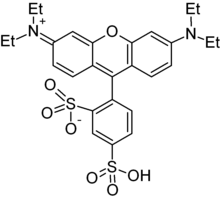Sulforhodamine B
Red fluorescent dye From Wikipedia, the free encyclopedia
Red fluorescent dye From Wikipedia, the free encyclopedia
Sulforhodamine B or Kiton Red 620 (C27H30N2O7S2) is a fluorescent dye with uses spanning from laser-induced fluorescence (LIF) to the quantification of cellular proteins of cultured cells. This red solid dye is very water-soluble.[1]
 | |
| Names | |
|---|---|
| IUPAC name
2-(3-diethylamino-6-diethylazaniumylidene-xanthen-9-yl)-5-sulfo-benzenesulfonate | |
| Identifiers | |
3D model (JSmol) |
|
| ChemSpider | |
| ECHA InfoCard | 100.020.482 |
| EC Number |
|
PubChem CID |
|
| UNII | |
CompTox Dashboard (EPA) |
|
| |
| |
| Properties | |
| C27H30N2O7S2 | |
| Molar mass | 558.666 g/mol |
Except where otherwise noted, data are given for materials in their standard state (at 25 °C [77 °F], 100 kPa).
| |
The dye has maximal absorbance at 565 nm light and maximal fluorescence emission at 586 nm light.[1] It does not exhibit pH-dependent absorption or fluorescence over the range of 3 to 10.[2]
Sulforhodamine B is often used as a membrane-impermeable polar tracer[3] or used for cell density determination via determination of cellular proteins (cytotoxicity assay).[4]
Seamless Wikipedia browsing. On steroids.
Every time you click a link to Wikipedia, Wiktionary or Wikiquote in your browser's search results, it will show the modern Wikiwand interface.
Wikiwand extension is a five stars, simple, with minimum permission required to keep your browsing private, safe and transparent.